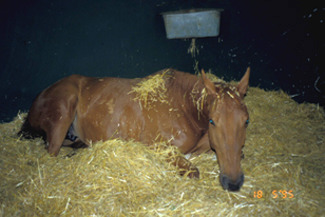Peritoneal fluid used to diagnose equine colic

An equine colic indicates severe abdominal pain originating in a part of the horse's digestive system. This causes spasms and can become life-threatening if not cured at once. The peritoneum is a membrane that forms the lining of the abdominal cavity. Its high level of fibrinolytic activity is set off by abdominal pains such as those appearing in severe cases of colics. The research carried out for this doctoral thesis confirms that the severity of gastrointenstinal processes can be diagnosed through the analysis of D-dimer concentration, a specific marker for fibrin degradation, in peritoneal fluid.
Peritoneum has a marked intrinsic fibrinolytic activity that is essential to reduce the adhesion formation from the fibrinous exudate generated after different abdominal injuries. In humans, adhesion formation has been attributed to a reduced peritoneal fibrinolytic activity in peritoneum following surgical trauma or peritonitis, represented by an increase of peritoneal plasminogen activator inhibitor (PAI-1), and a decrease of peritoneal tissue-type plasminogen activator (t-PA) and fibrin/fibrinogen degradation products (FDPs). In horses, few studies have been performed assessing fibrinolytic activity in peritoneal fluid, and an increase in peritoneal t-PA and fibrin degradation products concentration were observed in horses with colic, especially in those with endotoxemia.
Moreover, contamination of samples with blood may occur during peritoneal fluid collection, although it was demonstrated that up to 17% of blood contamination of peritoneal fluid did not significantly alter interpretation of the nucleated cell count or protein concentration in clinically normal horses.
D-dimer is a specific fibrin degradation marker that is useful to assess intravascular hypercoagulation and hyperfibrinolytic activity in horses with colic and septic neonates. However, no studies have been conducted in peritoneal fluid of horses with gastrointestinal disorders using D-dimer.
Therefore, the aim of the present thesis was to assess the fibrinolytic activity in peritoneal fluid of horses with colic by the determination of D-dimer concentration, t-PA and PAI-1 activities, according to the diagnosis of the gastrointestinal disorder, the type of peritoneal fluid analysis and the outcome. Finally, it was also determined whether blood contamination that may occur during abdominocentesis procedure could cause significant changes in peritoneal D-dimer concentration.
In this prospective study, peritoneal fluid and blood citrated samples were simultaneously collected upon admission to all horses with colic admitted to the Equine Teaching Hospital of Barcelona. Additionally, some control horses were also included.
To evaluate the effect of blood contamination, peritoneal fluid samples were contaminated with 1, 5, 10 and 20% of blood.
D-dimer concentration was determined in both peritoneal, plasma and contaminated samples using a quantitative immunoturbidimetric test. Peritoneal t-PA and PAI-1 activities were measured by an ELISA test.
A total of 236 horses were included in the prospective observational clinical study, and 38 in the experimental study. Peritoneal D-dimer concentration was significantly increased in all horses with colic, thus representing a strong activation of fibrinolytic activity in the peritoneum. The highest D-dimer values were observed in severe gastrointestinal disorders (peritonitis and inflammatory/ischemic diseases), and it was clearly correlated with an altered peritoneal fluid and a poor prognosis.
Horses with high peritoneal D-dimer values also had a decreased peritoneal t-PA and an increased peritoneal PAI-1 activities that could be explained by a consumption of peritoneal t-PA and a release of inhibitors (PAI-1) in response to inflammatory cytokines.
About blood contamination of peritoneal fluid samples, D-dimer concentration in peritoneal samples was only quantitatively affected when peritoneal fluid was contaminated at 20% of blood, particularly in those animals with low peritoneal D-dimer values (≤2,000 ng/mL). But the qualitative interpretation of the peritoneal D-dimer concentration was not significantly affected by blood contamination up to a 20% level of blood contamination because there were no significant differences between the ‘minimally contaminated’ (≤1% of blood) and ‘highly contaminated’ (≥5% of blood) groups.
In conclusion, the results of this thesis confirm that determination of D-dimer concentration in peritoneal fluid of horses with colic could be a useful test in emergency settings for the diagnosis of different gastrointestinal disorders, particularly to differentiate severe disorders from obstructive lesions. Therefore, the test can be used to assess peritoneal fibrin formation and fibrin degradation activity in gastrointestinal disorders, despite the peritoneal fluid sample was blood contaminated during the abdominocentesis procedure.
References
"Peritoneal fibrinolysis activity in horses with colic." PhD thesis read by Mª Ángeles Delgado Jorde on December 18, 2009 at 12 o'clock, in Sala de Graus of the Faculty of Veterinary, Universitat Autònoma de Barcelona. Director: Lluis Monreal i Bosch.


